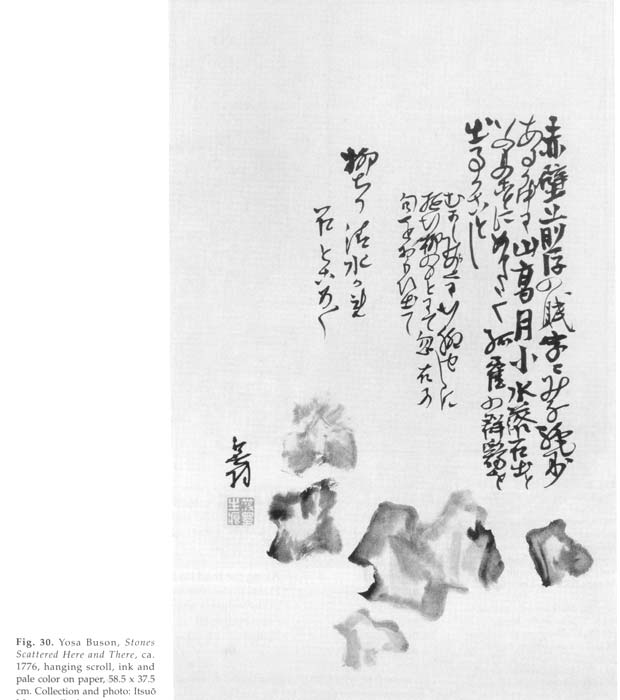I finally finished Rosenfield’s Mynah Birds and Flying Rocks: Word and Image in the Art of Yosa Buson, today, and I’ll have to admit that the chapter on “Rock Motifs and Reductive Symbols,” despite the title, was probably my favorite chapter in the book because it came the closest to showing the relationship between Buson’s art and Buson’s haiku, the main reason I bought the book in the first place.
Buson’s scroll entitled “Stones Scattered Here and There” contains three famous poems, one of his own, one by Basho, and one by Saigyo, and as Rosenfield notes:

Buson’s ltsu Museum rock painting thus connects himself, Basho, and Su Shi; it is an eloquent example of East Asian cultural memory in action, of poets and artists building on admired works of the past-not through imitation but through highly expressive variations on the older works. Basho and Saigyo had described a pleasant, welcoming spot (crystal waters, the sheltering willow), but for Buson ” characteristically – the tree was leafless and the crystal waters had dried up, leaving only rocks in the stream bed. This stark interpretation may well have been Buson’s own, though it had also appeared in a medieval No drama about the Traveller’s Willow, which described the tree as withered, its branches desolate, and the stream bed dry. 23 Regardless, Buson had darkened what earlier poets had made light and gracious. For him, as for T. S. Eliot, there is “only rock and no water”-the epitome of desolation.
A similar somber tone appears in other of Buson’s poems about rocks, all set in winter:
| Kogarashi ya Iwa ni sakeyuku Mizu no koe BS 2641; BZ-1 1301 Kogarashi ya Ishi ni shi o |
Freezing wind- The sound of water Splitting the rocks. Freezing wind- Writing a poem on a rock |
Originally, I was mostly interested in seeing the relationship between Buson’s pictures and his haiku, but it was interesting seeing the relationship between these three famous poets, and it is certainly a connection I would never have made without having it pointed out by Rosenfield.
Truthfully, though, if I had had more faith in the internet and had taken the time to research Buson’s art on-line I doubt that I would have purchased this book and, instead, would have focused on a better collection of Buson’s haiku, a book that I will have to purchase some time in the near future.
When I buy the work, I will try to relate these poems to a number of interesting Buson artworks I found on the web, all worth checking out on their own if you’re at all interested in Buson’s artwork:
Yuson: Chinese Historical Figures
Landscape with Solitary Figure
Yosa Buson and His Followers: Haiku & Painting, an extensive listing of links to both paintings and poems
